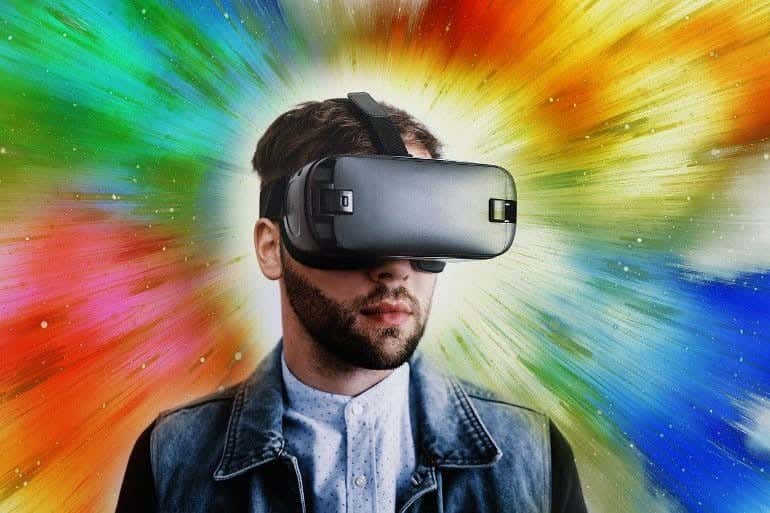Rollercoaster of emotions: Exploring emotions with virtual reality
The aim of the research was to find out what happens in participants’ brains while they experience emotionally engaging situations.

[Dec 17, 2021: Max Planck Institute for Human Cognitive and Brain Sciences]
What happens in participants' brains while they experience emotionally engaging situations? (CREDIT: Creative Commons)
To the left and right, the landscape drifts idly by, the track in front of you. Suddenly, a fire. The tension builds. The ride reaches its highest point. Only one thing lies ahead: the abyss. Plummeting down into the depths of the earth. These are scenes of a rollercoaster ride as experienced by participants in a recent study at the Max Planck Institute for Human Cognitive and Brain Sciences (MPI CBS) in Leipzig. However, not in real life, but virtually, with the help of virtual reality (VR) glasses. The aim of the research was to find out what happens in participants' brains while they experience emotionally engaging situations.
To find out how the human brain processes emotions, highly simplified experiments have been used until now. Researchers would show participants photos of emotional scenes and record their brain activity. The studies took place under controlled laboratory conditions, so that the results could be easily compared. However, the simulated situations were usually not particularly emotionally arousing and were far removed from the experiences we normally have. This is because emotions are continuously created through an interplay of past experiences and various external influences with which we interact. With regard to emotions, it is therefore particularly important to create situations that are perceived as real as possible. Only in this way can we assume that the simultaneously measured brain activation comes close to that which occurs in real life outside the laboratory. VR glasses provide a remedy here. Through them, participants can immerse themselves dynamically and interactively in situations and experience them close to reality. Emotions are thus evoked in a more natural way.
Related Stories
The results of the current study showed that the degree to which a person is emotionally aroused can be seen in a specific form of rhythmic brain activity, the so-called alpha oscillations. Accordingly, the lower the strength of this oscillation in the measured EEG signal, the higher the arousal. "The findings thus confirm earlier investigations from classical experiments and prove that the signals also occur under conditions that are closer to everyday life," says Simon M. Hofmann, one of the authors of the underlying study, which has now appeared in the scientific journal eLife. "Using alpha oscillations, we were able to predict how strongly a person experiences a situation emotionally. Our models learned which brain areas are particularly important for this prediction. Roughly speaking, the less alpha activity measured here, the more aroused the person is," explains author Felix Klotzsche.
"In the future, it could be possible to apply these findings and methods to practical applications beyond basic research," adds author Alberto Mariola. VR glasses, for example, are increasingly being used in psychological therapy. Neurophysiological information about the emotional state of patients could lead to an improvement in treatment. Therapists could, for instance, directly gain an insight into the current emotional feeling during an exposure situation without having to ask the patient directly and thus interrupt the situation.
The scientists investigated these relationships with the help of electroencephalography (EEG), which allowed them to record the participants’ brain waves during the virtual rollercoaster ride - in order to determine what happens in the brain during the ride. Additionally, the subjects were asked to rate afterwards how excited they were over the course of the VR experience using a video. In this way, the researchers wanted to find out whether the subjective sensations during the ride correlate with the measured data from brain activity. Since people differ in how much they like to ride on rollercoasters, it was irrelevant whether the situation was perceived as positive or negative. What mattered was the strength of the sensation.
For the evaluation, the researchers used three different machine learning models to predict the subjective sensations as accurately as possible from the EEG data. The authors thereby showed that with the help of these approaches, the connection between EEG signals and emotional feelings can also be confirmed under naturalistic conditions.
Note: Materials provided above by Max Planck Institute for Human Cognitive and Brain Sciences. Content may be edited for style and length.
Like these kind of feel good stories? Get the Brighter Side of News' newsletter.
Tags: #New_Discoveries, #Research, #VR, #Emotions, #Brain_News, #Science, #Computers, #The_Brighter_Side_of_News
Joshua Shavit
Science & Technology Writer | AI and Robotics Reporter
Joshua Shavit is a Los Angeles-based science and technology writer with a passion for exploring the breakthroughs shaping the future. As a contributor to The Brighter Side of News, he focuses on positive and transformative advancements in AI, technology, physics, engineering, robotics and space science. Joshua is currently working towards a Bachelor of Science in Business Administration at the University of California, Berkeley. He combines his academic background with a talent for storytelling, making complex scientific discoveries engaging and accessible. His work highlights the innovators behind the ideas, bringing readers closer to the people driving progress.



